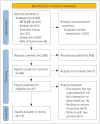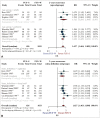Impact of the Occurrence While Sleeping of First Unprovoked Seizure on Seizure Recurrence: A Systematic Review
- PMID: 36367062
- PMCID: PMC9669549
- DOI: 10.3988/jcn.2022.18.6.642
Impact of the Occurrence While Sleeping of First Unprovoked Seizure on Seizure Recurrence: A Systematic Review
Abstract
Background and purpose: The impact of the occurrence while sleeping of first unprovoked seizure (FUS) on seizure recurrence in people with FUS is currently unclear. This uncertainty makes it challenging for physicians to determine whether to apply antiseizure medications (ASMs) to people with FUS while sleeping (FUS-S). This study aimed to determine the impact of the occurrence while sleeping of FUS.
Methods: We searched the MEDLINE, Embase, Cochrane Library, Web of Science, and Scopus electronic databases. Among retrieved studies, we selected those that provided information on the number of people with FUS, and relapsed people among these in each instance of FUS-S and FUS when waking (FUS-W). We used a random-effects model for meta-analyses.
Results: Of the 3,582 identified studies, 13 were eligible for systematic review. Seven of these 13 studies were deemed adequate for inclusion in a meta-analysis since they provided information at the time point of 2 years follow-up after FUS. The seven studies were of high quality regarding their risk of bias. When combining these 7 studies, the total sample comprised 1,659 people, of which 626 had FUS-S and 1,033 had FUS-W. The relative risk of seizure recurrence between FUS-S and FUS-W was 1.627. The seizure recurrence rates (SRRs) were 59.8% and 36.5% in the FUS-S and FUS-W groups, respectively.
Conclusions: We verified that the SRR was higher among people with FUS-S than FUS-W. After 2 years of follow-up, the SRR in people with FUS-S was about 60%. It is preferable to initiate an ASM for people with FUS-S.
Systematic review registration: PROSPERO registration number CRD42021266191.
Keywords: epilepsy; meta-analysis; prevalence; recurrence; seizures.
Copyright © 2022 Korean Neurological Association.
Conflict of interest statement
Oh-Young Kwon, a contributing editor of the
Figures




Similar articles
-
Immediate antiepileptic drug treatment, versus placebo, deferred, or no treatment for first unprovoked seizure.Cochrane Database Syst Rev. 2021 May 4;5(5):CD007144. doi: 10.1002/14651858.CD007144.pub3. Cochrane Database Syst Rev. 2021. PMID: 33942281 Free PMC article.
-
Short-term risk of relapse after a first unprovoked seizure in an adult population.Neurophysiol Clin. 2020 Apr;50(2):87-92. doi: 10.1016/j.neucli.2020.01.004. Epub 2020 Feb 14. Neurophysiol Clin. 2020. PMID: 32067861
-
First unprovoked seizures among soldiers recruited to the Israeli Defense Forces during 10 consecutive years: A population-based study.Epilepsia. 2024 Jan;65(1):127-137. doi: 10.1111/epi.17750. Epub 2023 Nov 28. Epilepsia. 2024. PMID: 37597251
-
Anti-seizure medications for Lennox-Gastaut syndrome.Cochrane Database Syst Rev. 2021 Apr 7;4(4):CD003277. doi: 10.1002/14651858.CD003277.pub4. Cochrane Database Syst Rev. 2021. PMID: 33825230 Free PMC article.
-
Risk of recurrence in patients with an unprovoked tonic-clonic seizure and generalized epileptiform discharges on EEG.Epilepsia. 2023 Aug;64(8):2153-2161. doi: 10.1111/epi.17671. Epub 2023 Jun 19. Epilepsia. 2023. PMID: 37264785
References
-
- Fisher RS, Acevedo C, Arzimanoglou A, Bogacz A, Cross JH, Elger CE, et al. ILAE official report: a practical clinical definition of epilepsy. Epilepsia. 2014;55:475–482. - PubMed
-
- Shinnar S, Berg AT, Ptachewich Y, Alemany M. Sleep state and the risk of seizure recurrence following a first unprovoked seizure in childhood. Neurology. 1993;43:701–706. - PubMed
-
- Hopkins A, Garman A, Clarke C. The first seizure in adult life. Value of clinical features, electroencephalography, and computerised tomographic scanning in prediction of seizure recurrence. Lancet. 1988;1:721–726. - PubMed
-
- Sathirapanya P, Praipanapong A, Kongkamol C, Chongphattararot P. Predictors of early recurrent seizure after first seizure presentation to an emergency service: a retrospective cohort study. Seizure. 2020;78:1–6. - PubMed
LinkOut - more resources
Full Text Sources

